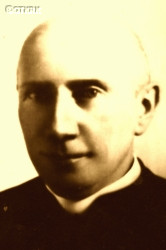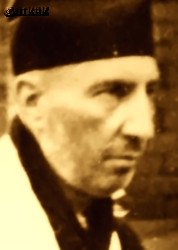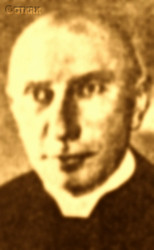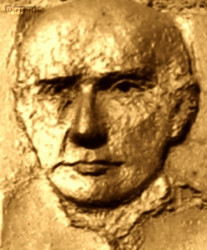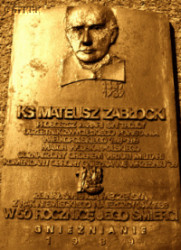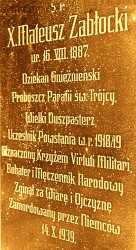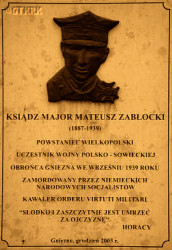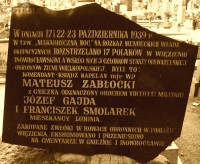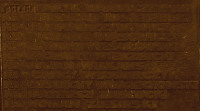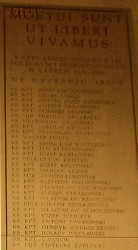Roman Catholic
St Sigismund parish
05-507 Słomczyn
85 Wiślana Str.
Konstancin deanery
Warsaw archdiocese, Poland
full list:
displayClick to display full list

searchClick to search full list by categories
wyświetlKliknij by wyświetlić pełną listę po polsku

szukajKliknij by przeszukać listę wg kategorii po polsku

Martyrology of the clergy — Poland
XX century (1914 – 1989)
personal data
surname
ZABŁOCKI
surname
versions/aliases
ŁADA—ZABŁOCKI
forename(s)
Matthew George (pl. Mateusz Jerzy)
function
diocesan priest
creed
Latin (Roman Catholic) Church RCmore on
en.wikipedia.org
[access: 2014.09.21]
diocese / province
Gniezno and Poznań archdiocese (aeque principaliter)more on
www.archpoznan.pl
[access: 2012.11.23]
RC Military Ordinariate of Polandmore on
en.wikipedia.org
[access: 2014.12.20]
honorary titles
„Cross of Independence”more on
en.wikipedia.org
[access: 2019.02.02]
(18.10.1932)
Gold „Cross of Merit”more on
en.wikipedia.org
[access: 2019.04.16]
(22.12.1928)
War Order of Virtuti Militari — Silver (5th Class)more on
en.wikipedia.org
[access: 2019.10.13]
(1921)
„Cross of Valour”more on
en.wikipedia.org
[access: 2019.04.16]
Commemorative Medal for War of 1918–21more on
pl.wikipedia.org
[access: 2019.10.13]
date and place
of death
14.10.1939

Inowrocławtoday: Inowrocław gm., Inowrocław pov., Kuyavia‐Pomerania voiv., Poland
more on
en.wikipedia.org
[access: 2021.07.18]
alt. dates and places
of death
17.10.1939
details of death
While studying at the Germ. Königliches Gymnasium (Eng. Royal Gymnasium) in Inowrocław, as a result of open opposition to the brutal Germanization of Polish children carried out at the school, severely beaten by a German teacher. Transferred to the Germ. Königliches Katholische Gymnasium (Eng. Royal Catholic Gymnasium) in Trzemeszno in Trzemeszno, where was a member of the clandestine self‐educational Polish youth organization Thomas Zan Society, and in 1907‐1908 its chairman.
At the end of World War I 1914‐1918, prob. became chaplain of the Gniezno branch of the clandestine Polish Military Organisation of the Prussian Partition POWZP, originating from scout organisations, aiming i.a. to incorporate deserters from the German army into its ranks, and main goal of which was the creation of an independent Polish state with Greater Poland as its part.
After the abdication on 09.11.1918 of the German Emperor William II Hohenzollern; after the signing on 11.11.1918 by the Allies and the Germans, in the staff wagon in Compiègne, at the headquarters of French Marshal Ferdinand Foch, of the armistice and ceasefire — which de facto meant the end of World War I; and also after the handover on 11.11.1918 by the Regency Council – operating in the so‐called Germ. Königreich Polen (Eng. Polish Kingdom) occupied by the Central Powers (Germany and Austria–Hungary) — of supreme command over the army to Brigadier Joseph Piłsudski and his appointment as Commander‐in‐Chief of the Polish Army, which de facto meant the rebirth of the Polish state, encompassing however only the Germ. Königreich Polen, i.e. the Polish territory under Russian rule until 1915, but excluding the lands of the Prussian partition; Greater Poland — as the Prussian Germ. Provinz Posen (Eng. Poznań Province) — was still formally part of the German state. In Gniezno, the seat of the Germ. Kreis Gnesen (Eng. Gniezno County), where due to the Germanisation policy, ⅔ of the land was in German hands, the Germans very quickly, on 10.11.1918, established a Soldiers' Council consisting of 17 Germans and 3 Poles — following the example of similar councils established all over Germany and aspiring to take over power in the state. The Poles responded on 11.11.1918 by establishing a Workers' Council with 18 Poles and 4 Germans in its composition. These councils took over supervision of offices and public places in the city. Soon, however, another council, the purely Polish District People's Council PRL, established on an appeal and drawing authority from the National People's Council in Poznań, began to dominate. On 20.11.1918, became its member, considered its most outstanding activist. Where possible, attempts were made to Polonize the city authorities and to introduce the Polish language in offices and schools. The establishment of armed units, however, encountered resistance from the Soldiers' Council — although there were clandestine Polish organizations in Gniezno, such as the POWZP, and acting in the open such as „Sokół” (Eng. „Falcon”) or scout organizations, their activity was severely limited, because Gniezno was a strong German garrison center: the Germ. 6. Pommersches Infanterie–Regiment Nr. 49 (Eng. 6th Pomeranian Infantry Regiment No. 49) and the Germ. 2. Brandenburgisches Dragoner–Regiment „von Arnim” Nr. 12 (Eng. 2nd Brandenburg Dragoon Regiment „von Arnim” No. 12) were stationed there.
On 27.12.1919, the Greater Poland Uprising broke out in Poznań. The very next day, 28.12.1919, an emissary of the insurgents, Sergeant Peter Walczak, arrived from Poznań. Despite the resistance from the chairman of the PRL, with some of its members went to the barracks of the German Infantry Regiment No. 49 and demanded that they be handed over to the Poles. While the talks were ongoing, others accompanying him disarmed the German guards, took over the weapons depot and disarmed 5 senior officers living in the city. The barracks were captured. On the night of 28‐29.12.1919, the post office was taken over, introducing exclusively Polish telephone service, and the gasworks, power plant, city hall, bank and railway station were captured. Then the same Peter Walczak went to the barracks of Dragoner Regiment No. 12. The insurgents entered the courtyard through the open gate, marched into the officers' mess and forced the Regiment commander to issue orders to leave the barracks. The disarmed soldiers left to the train station. Gniezno was in Polish hands. After a while, the Germans reacted and sent c. 400 soldiers and a battery of cannons from Bydgoszcz. The unit stopped in the village of Zdziechowa, c. 7 km north of Gniezno, the artillery in the village of Mączniki, 2 km further. Poles tried to negotiate, but the German conditions meant a return to the state before the Uprising. On 30.12.1918, 300‐400 Polish volunteers set off towards Zdziechowa. 120 reached the destination, the rest withdrew after encountering returning emissaries, who advised them: „there are too few of you… you won't make it”. In the fog, they managed however to take over part of the village and capture c. 8 officers and 50 German soldiers. Then it was the Germans who came up with a proposal for talks. Took part in them as a chaplain of the insurgents. A ceasefire was agreed and the Germans, convinced that they were surrounded by 1,500 insurgents, abandoned their positions with weapons in their hands. At night, however, the Germans broke the truce and opened fire, killing one insurgent. Further negotiations took place, in which the Germans agreed ...
to disarm.
On 31.12.1918, they left Gniezno for Poznań, without weapons.
The artillery unit in Mączniki remained though. When went there as an emissary of the insurgents, was apprehended, and the Germans withdrew to Żnin, taking him with them. In Bydgoszcz, was to stand before a German court and was sentenced to execution. Escaped death thanks to the intervention of a German pastor, and after 3 days was exchanged for German officers taken prisoner by the insurgents.
Returned to Gniezno, where several insurgent units were formed. One of them on 08.01.1919 set off to Szubin, where it was planned to attack the heavily defended town, which was the gateway to Bydgoszcz city. During the fighting, showed „exceptional heroism, leading the insurgent units into battle with a cross in his hand” — was even supposed to be briefly captured, but managed to escape. The battle ended in a defeat for the insurgents and the town was not captured that day. Returned therefore to Gniezno and on c. 18.01.1919 became a chaplain at the HQ of the northern front of the Uprising and of the 1st Northern Military District, with command of the military stating area in Gniezno. When the oath ceremony of the garrison in Gniezno took place on 09.02.1919, the regiment formed there was given the name of the 3rd Greater Poland Uhlan Regiment. Became its chaplain, as well as Gniezno garrison chaplain. The Uprising ended on 16.02.1919 with the armistice in Trier, enforced by the victorious Entente countries, by virtue of which the Polish insurgent Greater Poland Army was recognized as an allied force and a border was established, which „German troops were forbidden to cross”, leaving a large part of Greater Poland outside their influence. However, due to the lack of final political arrangements, constant German provocations and the obvious preparations by the Germans for military action, on 23.05.1919 the Regiment was transferred to the Noteć River region to protect the demarcation line there. Although the Treaty of Versailles was signed on 28.06.1919, by virtue of which Greater Poland was awarded to Poland, German provocations continued. It was not until early 08.1919 that the Regiment returned to Gniezno, where it continued its training. In the autumn of 1919 it again went to the north of Greater Poland, awaiting the entry into force of the Treaty of Versailles, which depended on its ratification by all parties, and the taking into possession of the lands granted to Poland by the treaty but still controlled by the Germans — in particular Pomerania.
The treaty came into force on 10.01.1920. Greater Poland became part of Poland. At that time, however, was already the chaplain of the 2nd Greater Poland Rifle Division of the Greater Poland Army, its titular parish priest, and at the same time the chaplain of the 7th Greater Poland Rifle Regiment. Accepted the nomination on 01.12.1919. Also in 01.1920, the Division — already a unit of the Polish Army — adopted the name of the 15th Greater Poland Infantry Division, and the regiment of the 61st Greater Poland Rifle Regiment. Went then with the Regiment to take over Pomerania. On 19.01.1920, entered Chodzież, from where continued march north. The Regiment returned to Chodzież on 01.03.1920, to accept the banner offered to him — led the ceremony to consecrate it. On 06.03.1920 the Regiment — whose fate largely reflects the fate of the entire Division — was sent to the front lines of the Polish–Russian War of 1919‐1921. Till 25.04.1920, and the beginning of the so‐called Kiev expedition, was stationed in the Brody–Krasne–Zlochiv concentration area in Ukraine. On that day moved east. On 27.04.1920 captured Berdychiv, then through Kozyatyn, which reached the next day, on 30.04.1920 entered Fastiv. On 08.05.1920 was in Kiev, where took part in a parade of the Polish army. Till 22.05.1920 was stationed in near Novosilky on the left bank of the Dnieper, and next — in the face of the Russian offensive on the Polish Lithuanian–Belarusian Front in the north — was transferred to Minsk, which was in Polish hands. The Russians, intending to relieve their southern front near Kiev, broke through in several places the Polish defensive line along the Berezina River, through a number of lakes, to the Dvina River — historically known as the Smolensk Gate, and the Regiment almost immediately began fighting north of Minsk, in the vicinity of Lahoysk. On 29.05.1920 it won a significant victory in the Battle of Pleshchanitsy, after which it pushed the Russians back beyond the Berezina. For over a month it defended the line of the upper Berezina in constant clashes and sorties. There, on 15.06.1920, during a raid beyond the Berezina River, after crossing the bridge near the village of Berezina and approaching the Kadlubishche farm, „the 1st Battalion of the 67th Infantry Regiment finds itself in a critical position and is attacked en masse. The units, taken by surprise, unexpectedly began to retreat in panic […] Sensing the danger awaiting the units during their further retreat, runs 50 meters in front of the line, calling out to the soldiers at the top of his voice and encouraging them with words. Himself marks the line of defense and stops them. The soldiers, embarrassed and at the same time encouraged by [the chaplain's] courage, stand on the line designated by him and defend the position almost to the last cartridge, repelling continuous enemy attacks”. The application for the Virtuti Militari order also added: „Thanks to this, the left and right wing units, which were deployed ahead, managed to retreat to the same level as the 1st battalion, and were saved from certain captivity”.
On 04.07.1920 a major Russian offensive began in the north, under the command of General Mikhail Tukhachevsky. The Polish troops retreated. In continuous fighting the Regiment through Vawkavysk, the Bug line, withdrew to Warsaw. There, on the outskirts of the capital, it took defensive positions along the Świder River, between Okuniew and Warsaw. On c. 15.08.1920, the decisive Battle of Warsaw (known as the „Miracle on the Vistula”) began. The Polish counterattack came from the Wieprz River, from where Polish units attacked northward, striking the flank of the attacking Russians and cutting off their front units from their rear. The Regiment joined the counterattack, striking and recapturing Mińsk Mazowiecki on 17.08.1920, then Małkinia on 20.08.1920, and then through Śniadów, where it fought a bloody battle, reached Kolno. There, it forced the Rus. 2‐й конный Кавказский корпус (Eng. 2nd Caucasian Cavalry Corps), known as the Kavkor, under the command of Hayk Byzhyshkian, known as Gai‐Khan — renowned for numerous murders, rapes and robberies — to cross the border with German East Prussia, where was interned. Then, on 24‐26.09.1920 fighting near Vawkavysk, the Regiment took part in the second, most important battle of the war, the Battle of the Neman River on 20‐28.09.1920. The Polish victory led to the further displacement of the Russians to the east — on 11.10.1920 the Regiment fought near Koydaniv, and then on 15.10.1920 it found itself near Minsk. Was there that the armistice was announced. On 11.1920 it returned to Greater Poland, to Gniezno.
His duties included ministry not only in the 61st Regiment, but also in the entire 15th Division. „In the combat history [not only] of the regiment, but of the entire Polish army, wrote his name in golden letters as a priest–hero”— states the Regiment's monograph.
In 1923, 1927,1924, 1925, and 1929 appointed reserve chaplain of the Polish Army (from 25.11.1926 each time for a statutory period of 2 years).
In 1931 signed a collective protest against imprisonment in the Brest fortress and brutal treatment of the parliamentary opposition (of the so‐called Centrolew).
According to some sources, in 1939 took part in preparations for the creation — in the event of the outbreak of war and the beginning of the occupation — of clandestine off‐front diversion units, which later actually took the form of the Clandestine Military Organization TOW.
During German invasion of Poland started on 01.09.1939 (Russians invaded Poland 17 days later), after start of the World War II, commander of Polish Gniezno defence effort.
On 10.09.1939 while driving a car with a white peace flag, , attempting to commence talks with the Germans on the terms of Gniezno surrender, wishing to protect the historic city and its monuments from destruction, pelted with grenades by the Germans near Żydowo, c. 9 km from Gniezno.
Injured — suffered a left forearm wound.
Interrogated, insulted and tortured by the Germans in the hospital.
On 12‐13.10.1939 arrested by the Germans.
Transported to the prison in Inowrocław and sentenced there — according to sources, by the Germ. Sondergericht Hohensalza (Eng. Special Court in Inowrocław), but the designation „Field Martial Court” on a poster announcing his execution, made public on 14.10.1939 in Inowrocław, indicates that it could have been the Germ. Feldskriegsgericht (Eng. Field Military Court) — twice to death: for taking part in defence of Gniezno and for participation in Greater Poland Uprising in 1918‐1919.
Executed in the prison yard or in a nearby secluded forest, where years later his body was found, together with 13 officers of Polish Army.
cause of death
murder
perpetrators
Germans
sites and events
InowrocławClick to display the description, «Intelligenzaktion»Click to display the description, Ribbentrop‐MolotovClick to display the description, Pius XI's encyclicalsClick to display the description, Polish‐Russian war of 1919‐1921Click to display the description, Greater Poland UprisingClick to display the description, Thomas Zan SocietiesClick to display the description
date and place
of birth
16.08.1887

Żurawicetoday: Boniewo gm., Włocławek pov., Kuyavia‐Pomerania voiv., Poland
more on
en.wikipedia.org
[access: 2021.12.18]
parents
ZABŁOCKI Sigismund
🞲 1852, Czerlintoday: Gołańcz gm., Wągrowiec pov., Greater Poland voiv., Poland
more on
en.wikipedia.org
[access: 2025.02.20] — 🕆 23.12.1921, Poznańtoday: Poznań city pov., Greater Poland voiv., Poland
more on
en.wikipedia.org
[access: 2021.07.18]

OSTOJA—LNISKA Helen
🞲 1856, ? — 🕆 ?, ?
presbyter (holy orders)
ordination
15.02.1913

Gnieznotoday: Gniezno urban gm., Gniezno pov., Greater Poland voiv., Poland
more on
en.wikipedia.org
[access: 2021.12.18]
Assumption of the Blessed Virgin Mary RC archcathedral churchmore on
en.wikipedia.org
[access: 2025.03.14]
positions held
1923 – 1939
dean — Gnieznotoday: Gniezno urban gm., Gniezno pov., Greater Poland voiv., Poland
more on
en.wikipedia.org
[access: 2021.12.18] RC deanery
1923 – 1939
parish priest — Gnieznotoday: Gniezno urban gm., Gniezno pov., Greater Poland voiv., Poland
more on
en.wikipedia.org
[access: 2021.12.18] ⋄ Holy Trinity RC parish (main parish) ⋄ Gnieznotoday: Gniezno urban gm., Gniezno pov., Greater Poland voiv., Poland
more on
en.wikipedia.org
[access: 2021.12.18] RC deanery — also: c. 1934‐ 1939 member of the Council of Parish Priests–Consultors of the Archbishop's Curia, c. 1929 ‐ 1939 pro‐synodal judge of the Metropolitan Archbishop's Court, c. 1929 ‐1939 county inspector of religion classes in elementary schools, c. 1929 ‐1939 member of the Lat. „Consilium a Vigilantiae” (Eng. „Committee on Morals”) of the Archbishop's Curia; publisher of „Parish Church News”; councillor of the Gniezno City Council; co‐organiser of the city branch of the Polish Red Cross PCK; from 1924 president of the district branch of the Polish Anti‐Alcohol League; from 1928 president of the district board of the Society of People's Reading Rooms and member of its Main Board; from 1931 president of the branch of the „Polish Care for Compatriots Abroad” Association; member of the board of the Union of Insurgents' and Soldiers' Societies of the Western Lands of the Republic of Poland; chaplain of the Gniezno District of the Union of Gymnastic Societies „Sokół” (Eng. „Falcon”)
1921 – 1923
parish priest — Gnieznotoday: Gniezno urban gm., Gniezno pov., Greater Poland voiv., Poland
more on
en.wikipedia.org
[access: 2021.12.18] ⋄ St Lawrence the Martyr RC parish ⋄ Gniezno Holy Trinitydeanery name
today: Gniezno urban gm., Gniezno pov., Greater Poland voiv., Poland
more on
en.wikipedia.org
[access: 2021.12.18] RC deanery
1920 – c. 1921
RC senior military chaplain — Polish Armed Forces — from 01.1920 titular military pastor of the 15th Greater Poland Infantry Division and regimental chaplain of the 61st Greater Poland Rifle Regiment; prob. in 1921 verified as a senior chaplain of the Roman Catholic faith, with the rank of major (in 1923 recorded as a senior reserve chaplain, with seniority from 01.06.1919 and 25th place among senior chaplains of the military clergy of the Roman Catholic faith); formally accepted into the Polish Army as a Roman Catholic chaplain by L. 2238 decree of the Commander‐in‐Chief of 30.07.1920
1919 – 1920
RC military chaplain — Gnieznotoday: Gniezno urban gm., Gniezno pov., Greater Poland voiv., Poland
more on
en.wikipedia.org
[access: 2021.12.18] ⋄ Greater Poland Army (i.e. Polish Armed Forces in the former Prussian Partition), Polish Armed Forces — 01.12.1919‐10.01.1920 titular pastor of the 2nd Greater Poland Rifle Division and chaplain of the 7th Greater Poland Rifle Regiment; 09.02.1919‐01.12.1919 chaplain of the 3rd Greater Poland Uhlan Regiment and the Gniezno garrison; c. 18.01.1919‐09.02.1919 chaplain at the HQ of the northern front of the Uprising and the I Northern Military District
1916 – 1919
vicar — Gnieznotoday: Gniezno urban gm., Gniezno pov., Greater Poland voiv., Poland
more on
en.wikipedia.org
[access: 2021.12.18] ⋄ Holy Trinity RC parish (main parish) ⋄ Gniezno Holy Trinitydeanery name
today: Gniezno urban gm., Gniezno pov., Greater Poland voiv., Poland
more on
en.wikipedia.org
[access: 2021.12.18] RC deanery
1914 – 1916
vicar — Kruszwicatoday: Kruszwica gm., Inowrocław pov., Kuyavia‐Pomerania voiv., Poland
more on
en.wikipedia.org
[access: 2021.07.18] ⋄ St Peter and St Paul the Apostles RC collegiate parish ⋄ Kruszwicatoday: Kruszwica gm., Inowrocław pov., Kuyavia‐Pomerania voiv., Poland
more on
en.wikipedia.org
[access: 2021.07.18] RC deanery
1913 – 1914
vicar — Kamieniectoday: Trzemeszno gm., Gniezno pov., Greater Poland voiv., Poland
more on
en.wikipedia.org
[access: 2021.07.18] ⋄ St James the Great the Apostle RC parish ⋄ Gniezno St Michael the Archangeldeanery name
today: Gniezno urban gm., Gniezno pov., Greater Poland voiv., Poland
more on
en.wikipedia.org
[access: 2021.12.18] RC deanery
1913
vicar — Mogilnotoday: Mogilno gm., Mogilno pov., Kuyavia‐Pomerania voiv., Poland
more on
en.wikipedia.org
[access: 2021.12.18] ⋄ St James the Great the Apostle RC parish ⋄ Żnintoday: Żnin gm., Żnin pov., Kuyavia‐Pomerania voiv., Poland
more on
en.wikipedia.org
[access: 2021.06.20] RC deanery
till 1913
student — Gnieznotoday: Gniezno urban gm., Gniezno pov., Greater Poland voiv., Poland
more on
en.wikipedia.org
[access: 2021.12.18] ⋄ philosophy and theology, Archbishop's Practical Theological Seminary (Lat. Seminarium Clericorum Practicum)
from 1909
student — Poznańtoday: Poznań city pov., Greater Poland voiv., Poland
more on
en.wikipedia.org
[access: 2021.07.18] ⋄ philosophy and theology, Archbishop's Theological Seminary (Collegium Leoninum)
till 1939
membership — People's Reading Rooms Society TCL — also: 1930‐1932 vice‐president of the Main Board of TCL; 1928 member of the Main Council of TCL; president of the board of TCL in the Gniezno county
others related
in death
BUŁAWSKIClick to display biography Mieczyslav Vaclav, GLATZELClick to display biography Charles Augustus Stanislav
sites and events
descriptions
Inowrocław: German prison and detention center at Pakoska Str. (today Narutowicza Str.). In 1939, the Germans held there hundreds of Poles from Inowrocław and the surrounding area, arrested as part of the «Intelligenzaktion» program — the physical extermination of the Polish intelligentsia and leadership classes. By 11.1939, 546 of them were murdered in the prison and the surrounding area (e.g. in Rożniaty and Zajezierze), including 56 people on the night of 22‐23.10.1939, the murder carried out after the collective libation of the Germans, which the German landrat, i.e. the occupying district official, a certain Hirschfeld, was said to have initiated by saying: „well, now we will go and shoot the Poles”. Later, it was also a place of execution for many Poles. After the Russian occupation began in 1945, the communist prison, also for women. (more on: www.inowroclawfakty.plClick to attempt to display webpage
[access: 2013.05.19])
«Intelligenzaktion»: German: «Intelligenzaktion» (English: „Intelligence Action”) — a German program of extermination of the Polish elite, mainly the intelligentsia and leadership layers, carried out from the beginning of the occupation in w 09.1939 to 04.1940, mainly in territories directly annexed to Germany, but also in the so‐called Germ. Generalgouvernement (Eng. General Governorate), where it was called «AB‐aktion». In the first phase, immediately after the beginning of the German occupation, during military operations carried out by the Germ. Wehrmacht (Eng. Armed Forces) and the genocidal units of the Germ. Einsatzgruppen (Eng. Operational Groups) of the Germ. Sicherheitspolizei (Eng. Security Police), i.e. SiPo, and Germ. Sicherheitsdienst des Reichsführers SS (Eng. Security Service of the Reichsführer SS), i.e. SD, organized by the Germ. Reichssicherheitshauptamt (Eng. Reich Main Security Office), i.e. RSHA, which followed the troops, carried out under the Germ. Unternehmen „Tannenberg” (Eng. Operation „Tannenberg”) — based on the so‐called Germ. Sonderfahndungsliste (Eng. Special Wanted Lists), i.e. proscription lists of Poles considered particularly dangerous to the Third Reich, prepared by the Zentralstelle II/P (Polen) unit of the German RSHA. Later, implemented by the German civilian occupation authorities and the genocidal unit of the Germ. Volksdeutscher Selbstschutz (Eng. Ethnic Germans Self‐Defense), whose members were Germ. Volksdeutsche (Eng. Ethnic Germans), i.e. representatives of the German minority in Poland. According to various sources, these lists, at the beginning of 09.1939, could have contained the details of 61,000—88,000 „dangerous” Poles — although these figures cannot be confirmed. In total, during this genocide, c. 50,000 teachers, Catholic priests, representatives of the landed gentry, freelancers, social and political activists, and retired military personnel were systematically and methodically murdered. Another 50,000 were sent to concentration camps, where only a negligible percentage survived. (more on: en.wikipedia.orgClick to attempt to display webpage
[access: 2014.10.04])
Ribbentrop‐Molotov: Genocidal Russian‐German alliance pact between Russian leader Joseph Stalin and German leader Adolf Hitler signed on 23.08.1939 in Moscow by respective foreign ministers, Mr. Vyacheslav Molotov for Russia and Joachim von Ribbentrop for Germany. The pact sanctioned and was the direct cause of joint Russian and German invasion of Poland and the outbreak of the World War II in 09.1939. In a political sense, the pact was an attempt to restore the status quo ante before 1914, with one exception, namely the „commercial” exchange of the so‐called „Kingdom of Poland”, which in 1914 was part of the Russian Empire, fore Eastern Galicia (today's western Ukraine), in 1914 belonging to the Austro‐Hungarian Empire. Galicia, including Lviv, was to be taken over by the Russians, the „Kingdom of Poland” — under the name of the General Governorate — Germany. The resultant „war was one of the greatest calamities and dramas of humanity in history, for two atheistic and anti‐Christian ideologies — national and international socialism — rejected God and His fifth Decalogue commandment: Thou shall not kill!” (Abp Stanislav Gądecki, 01.09.2019). The decisions taken — backed up by the betrayal of the formal allies of Poland, France and Germany, which on 12.09.1939, at a joint conference in Abbeville, decided not to provide aid to attacked Poland and not to take military action against Germany (a clear breach of treaty obligations with Poland) — were on 28.09.1939 slightly altered and made more precise when a treaty on „German‐Russian boundaries and friendship” was agreed by the same murderous signatories. One of its findings was establishment of spheres of influence in Central and Eastern Europe and in consequence IV partition of Poland. In one of its secret annexes agreed, that: „the Signatories will not tolerate on its respective territories any Polish propaganda that affects the territory of the other Side. On their respective territories they will suppress all such propaganda and inform each other of the measures taken to accomplish it”. The agreements resulted in a series of meeting between two genocidal organization representing both sides — German Gestapo and Russian NKVD when coordination of efforts to exterminate Polish intelligentsia and Polish leading classes (in Germany called «Intelligenzaktion», in Russia took the form of Katyń massacres) where discussed. Resulted in deaths of hundreds of thousands of Polish intelligentsia, including thousands of priests presented here, and tens of millions of ordinary people,. The results of this Russian‐German pact lasted till 1989 and are still in evidence even today. (more on: en.wikipedia.orgClick to attempt to display webpage
[access: 2015.09.30])
Pius XI's encyclicals: Facing the creation of two totalitarian systems in Europe, which seemed to compete with each other, though there were more similarities than contradictions between them, Pope Pius XI issued in 03.1937 (within 5 days) two encyclicals. In the „Mit brennender Sorge” (Eng. „With Burning Concern”) published on 14.03.1938, condemned the national socialism prevailing in Germany. The Pope wrote: „Whoever, following the old Germanic‐pre‐Christian beliefs, puts various impersonal fate in the place of a personal God, denies the wisdom of God and Providence […], whoever exalts earthly values: race or nation, or state, or state system, representatives of state power or other fundamental values of human society, […] and makes them the highest standard of all values, including religious ones, and idolizes them, this one […] is far from true faith in God and from a worldview corresponding to such faith”. On 19.03.1937, published „Divini Redemptoris” (Eng. „Divine Redeemer”), in which criticized Russian communism, dialectical materialism and the class struggle theory. The Pope wrote: „Communism deprives man of freedom, and therefore the spiritual basis of all life norms. It deprives the human person of all his dignity and any moral support with which he could resist the onslaught of blind passions […] This is the new gospel that Bolshevik and godless communism preaches as a message of salvation and redemption of humanity”… Pius XI demanded that the established human law be subjected to the natural law of God , recommended the implementation of the ideal of a Christian state and society, and called on Catholics to resist. Two years later, National Socialist Germany and Communist Russia came together and started World War II. (more on: www.vatican.vaClick to attempt to display webpage
[access: 2023.05.28], www.vatican.vaClick to attempt to display webpage
[access: 2023.05.28])
Polish‐Russian war of 1919‐1921: War for independence of Poland and its borders. Poland regained independence in 1918 but had to fight for its borders with former imperial powers, in particular Russia. Russia planned to incite Bolshevik‐like revolutions in the Western Europe and thus invaded Poland. Russian invaders were defeated in 08.1920 in a battle called Warsaw battle („Vistula river miracle”, one of the 10 most important battles in history, according to some historians). Thanks to this victory Poland recaptured part of the lands lost during partitions of Poland in XVIII century, and Europe was saved from the genocidal Communism. (more on: en.wikipedia.orgClick to attempt to display webpage
[access: 2014.12.20])
Greater Poland Uprising: Military insurrection of Poles of former German Germ. Posen Provinz (Eng. Poznań province) launched against German Reich in 1918‐1919 — after the abdication on 09.11.1918 of the German Emperor William II Hohenzollern; after the armistice between the Allies and Germany signed on 11.1.1918 in the HQ wagon in Compiègne, the headquarters of Marshal of France Ferdinand Foch — which de facto meant the end of World War I — against the German Weimar Republic, established on the ruins of the German Empire, aiming to incorporate lands captured by Prussia during partitions of Poland in XVIII century into Poland. The Republic of Poland, reborn on 11.11.1918, initially formally included only the so‐called Germ. Königreich Polen (Eng. Kingdom of Poland), i.e. the territory that had been under Russian rule until 1915 and then under the control of Central States (Germany and Austria–Hungary), but did not include the Prussian partition. Started on 27.12.1918 in Poznań and ended on 16.02.1919 with the armistice pact in Trier, forced by the victorious Entente states, which included provisions ordering Germany to cease operations against Poland and, importantly, recognizing the Polish insurgent Greater Poland Army as an allied armed force of the Entente. De facto it turned out to be a Polish victory, confirmed in the main peace treaty after World War I, the Treaty of Versailles of 28.06.1919, which came into force on 10.01.1920 and in which most of the lands of the Prussian partition were recognized as Polish. Many Polish priests took part in the Uprising, both as chaplains of the insurgents units and members and leaders of the Polish agencies and councils set up in the areas covered by the Uprising. In 1939 after German invasion of Poland and start of the World War II those priests were particularly persecuted by the Germans and majority of them were murdered. (more on: en.wikipedia.orgClick to attempt to display webpage
[access: 2016.08.14])
Thomas Zan Societies: Secret societies of Polish youth, aiming at self‐education, patriotic in form and content, functioning 1830‐1920, in mutiny against enforced Germanisation and censure of Polish culture, mainly in secondary schools — gymnasia — mainly in Greater Poland (Wielkopolska) and later in Silesia. The first groups were formed in 1817. In 1897 a congress in Bydgoszcz was held when rules of clandestine activities were formulated. At other congress in Bydgoszcz in Poznań a „Red Rose” society was formed, heading all others groups in various gymnasiums and coordinating their activities. In 1900 „Red Rose” consolidated Philomaths organizations from Pomerania as well. After Toruń trial of Pomeranian Philomaths in Toruń Germans arrested 24 members of Thomas Zan Society from Gniezno. 21 of them were sentenced up to 6 weeks in prison and reprimands. All were relegated from schools without the right to continue education in secondary and higher schools in Prussia. Despite repression the Societies existed till 1918 and rebirth of Poland. (more on: pl.wikipedia.orgClick to attempt to display webpage
[access: 2021.12.19])
sources
personal:
www.wtg-gniazdo.orgClick to attempt to display webpage
[access: 2012.11.23], www.inowroclawfakty.plClick to attempt to display webpage
[access: 2013.05.19], katolicy1844.republika.plClick to attempt to display webpage
[access: 2015.09.30], www.powstaniewlkp.fora.plClick to attempt to display webpage
[access: 2013.08.10], pl.wikipedia.orgClick to attempt to display webpage
[access: 2013.12.27], www.youtube.comClick to attempt to display webpage
[access: 2021.12.19], wbh.wp.mil.plClick to attempt to display webpage
[access: 2025.08.19]
bibliographical:
„Social Activist Priests in Greater Poland”, collective work, Biographical Dictionary, vol. 4 Ś‐Ż, Gniezno 2009
original images:
pl.wikipedia.orgClick to attempt to display webpage
[access: 2015.09.30], niemieckiezbrodnie39-45.blogspot.comClick to attempt to display webpage
[access: 2018.09.23], www.archidiecezja.plClick to attempt to display webpage
[access: 2015.09.30], gniezno1966.wordpress.comClick to attempt to display webpage
[access: 2015.09.30], gniezno1966.wordpress.comClick to attempt to display webpage
[access: 2014.01.06], cgw.poznan.uw.gov.plClick to attempt to display webpage
[access: 2014.01.06], www.gimnazjum2gniezno.republika.plClick to attempt to display webpage
[access: 2014.01.06], www.wtg-gniazdo.orgClick to attempt to display webpage
[access: 2012.11.23], www.katedrapolowa.plClick to attempt to display webpage
[access: 2014.01.16]
LETTER to CUSTODIAN/ADMINISTRATOR
If you have an Email client on your communicator/computer — such as Mozilla Thunderbird, Windows Mail or Microsoft Outlook, described at WikipediaPatrz:
en.wikipedia.org, among others — try the link below, please:
LETTER to CUSTODIAN/ADMINISTRATORClick and try to call your own Email client
If however you do not run such a client or the above link is not active please send an email to the Custodian/Administrator using your account — in your customary email/correspondence engine — at the following address:

giving the following as the subject:
MARTYROLOGY: ZABŁOCKI Matthew George
To return to the biography press below:
 Click to return to biography
Click to return to biography








